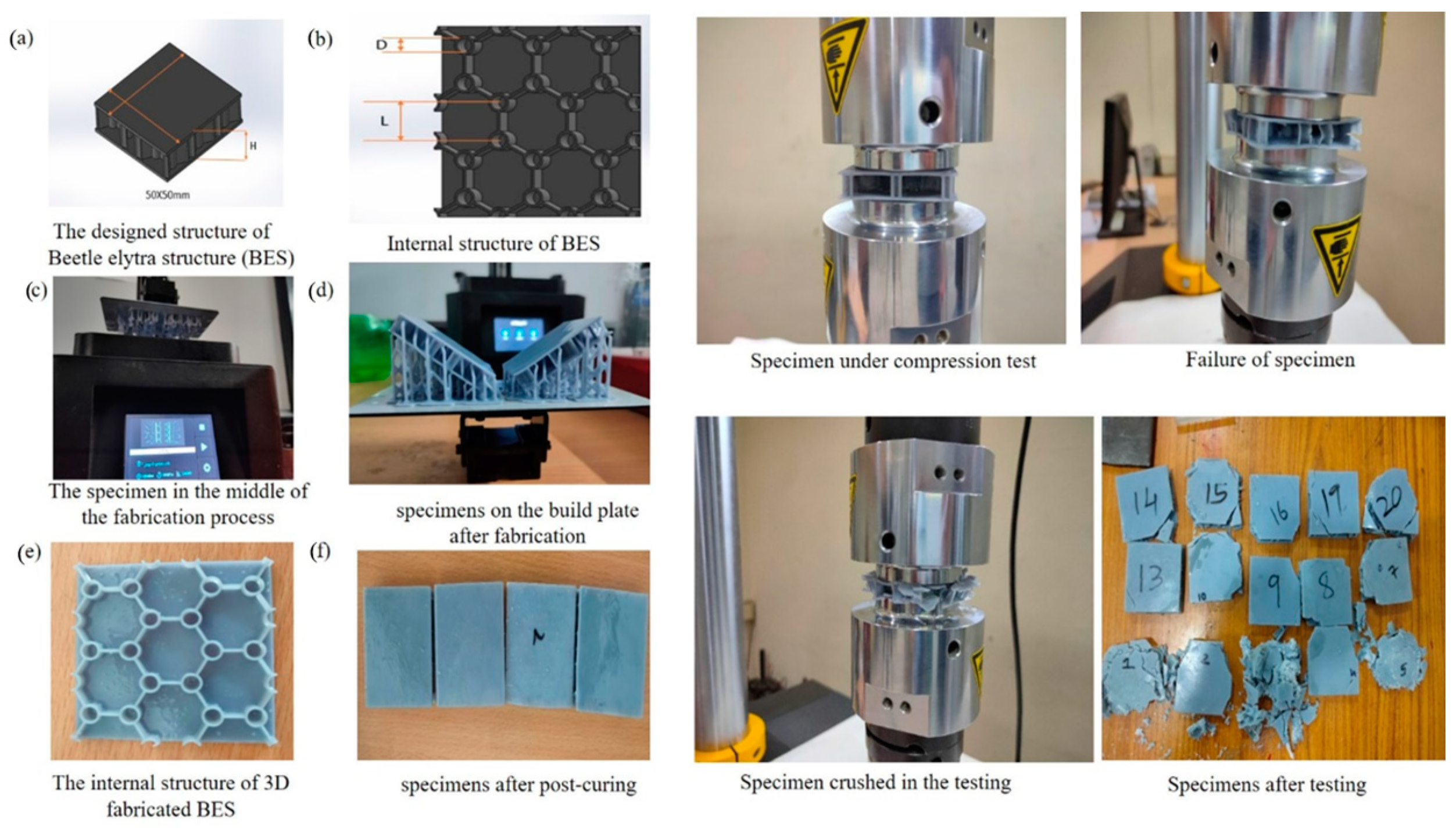Energy Absorption Capacity of Bio-Inspired Honeycomb Integrated Beetle Elytron Plates †
Abstract
1. Introduction
Beetle Elytra Structure (BES) and Honeycomb Structure (HCS)
2. Materials and Methods
- ❖
- Length of the wall [L] =
- ❖
- Diameter of hollow cylinder[D] =
- ❖
- Thickness of both wall cylinders [T] =
- ❖
- Height[H] = 10 mm
3. Results and Discussion
4. Conclusions and Future Scope
Author Contributions
Funding
Institutional Review Board Statement
Informed Consent Statement
Data Availability Statement
Conflicts of Interest
References
- Liu, J.; Liu, W.; Pantula, A.; Wang, Z.; Gracias, D.H.; Nguyen, T.D. Periodic buckling of soft 3D printed bioinspired tubes. Extrem. Mech. Lett. 2019, 30, 100514. [Google Scholar] [CrossRef]
- Ramakrishna, D.; Bala Murali, G. Bio-inspired 3D-printed lattice structures for energy absorption applications: A review. Proc. Inst. Mech. Eng. Part L J. Mater. Des. Appl. 2022, 237, 503–542. [Google Scholar] [CrossRef]
- Zhang, L.; Bai, Z.; Bai, F. Crashworthiness design for bio-inspired multi-cell tubes with quadrilateral, hexagonal and octagonal sections. Thin-Walled Struct 2018, 122, 42–51. [Google Scholar] [CrossRef]
- Yu, X.; Pan, L.; Chen, J.; Zhang, X.; Wei, P. Experimental and numerical study on the energy absorption abilities of trabecular–honeycomb biomimetic structures inspired by beetle elytra. J. Mater. Sci. 2019, 54, 2193–2204. [Google Scholar] [CrossRef]
- Xiang, J.; Du, J.; Li, D.; Scarpa, F. Numerical analysis of the impact resistance in aluminum alloy bi-tubular thin-walled structures designs inspired by beetle elytra. J. Mater. Sci. 2017, 52, 13247–13260. [Google Scholar] [CrossRef]
- Doodi, R.; Balamurali, G. Experimental and analytical investigation of bio-inspired lattice structures under compressive loading. Eng. Res. Express 2023, 5, 035035. [Google Scholar] [CrossRef]
- Chouhan, G.; Gunji, B.M.; Bidare, P.; Ramakrishna, D.; Kumar, R. Experimental and numerical investigation of 3D printed bio-inspired lattice structures for mechanical behaviour under quasi-static loading conditions. Mater. Today Commun. 2023, 35, 105658. [Google Scholar] [CrossRef]
- Zhang, X. Influence of honeycomb dimensions and forming methods on the compressive properties of beetle elytron plates. J. Sandw. Struct. Mater. 2020, 22, 28–39. [Google Scholar] [CrossRef]
- Wang, D.; Bai, Z. Mechanical property of paper honeycomb structure under dynamic compression. Mater. Des. 2015, 77, 59–64. [Google Scholar] [CrossRef]
- Doodi, R.; Gunji, B.M. Prediction and experimental validation approach to improve performance of novel hybrid bio-inspired 3D printed lattice structures using artificial neural networks. Sci. Rep. 2023, 13, 7763. [Google Scholar] [CrossRef] [PubMed]
- Panda, B.N.; Biswal, B.B.; Deepak, B.B.L.V. Integrated AHP and fuzzy TOPSIS Approach for the Selection of a Rapid Prototyping Process under Multi-Criteria Perspective. In Proceedings of the 5th International & 26th All India Manufacturing Technology, Design and Research Conference (AIMTDR 2014), IIT Guwahati, Assam, India, 12–14 December 2014. [Google Scholar]



| Specimen/Run Order | Thickness (mm) | Length (mm) | Diameter (mm) |
|---|---|---|---|
| 1 | 0.75 | 8 | 6 |
| 2 | 0.625 | 10 | 5 |
| 5 | 0.5 | 8 | 6 |
Disclaimer/Publisher’s Note: The statements, opinions and data contained in all publications are solely those of the individual author(s) and contributor(s) and not of MDPI and/or the editor(s). MDPI and/or the editor(s) disclaim responsibility for any injury to people or property resulting from any ideas, methods, instructions or products referred to in the content. |
© 2024 by the authors. Licensee MDPI, Basel, Switzerland. This article is an open access article distributed under the terms and conditions of the Creative Commons Attribution (CC BY) license (https://creativecommons.org/licenses/by/4.0/).
Share and Cite
Doodi, R.; Harsha, K.S.; Gunji, B.M.; Mahapatra, G.S. Energy Absorption Capacity of Bio-Inspired Honeycomb Integrated Beetle Elytron Plates. Eng. Proc. 2024, 66, 11. https://doi.org/10.3390/engproc2024066011
Doodi R, Harsha KS, Gunji BM, Mahapatra GS. Energy Absorption Capacity of Bio-Inspired Honeycomb Integrated Beetle Elytron Plates. Engineering Proceedings. 2024; 66(1):11. https://doi.org/10.3390/engproc2024066011
Chicago/Turabian StyleDoodi, Ramakrishna, Kaduvula Sri Harsha, Bala Murali Gunji, and G. S. Mahapatra. 2024. "Energy Absorption Capacity of Bio-Inspired Honeycomb Integrated Beetle Elytron Plates" Engineering Proceedings 66, no. 1: 11. https://doi.org/10.3390/engproc2024066011
APA StyleDoodi, R., Harsha, K. S., Gunji, B. M., & Mahapatra, G. S. (2024). Energy Absorption Capacity of Bio-Inspired Honeycomb Integrated Beetle Elytron Plates. Engineering Proceedings, 66(1), 11. https://doi.org/10.3390/engproc2024066011






